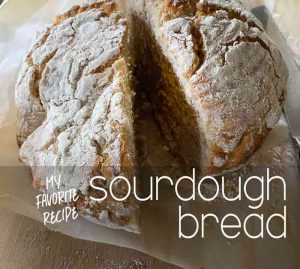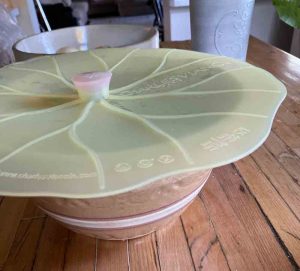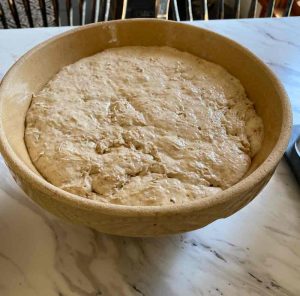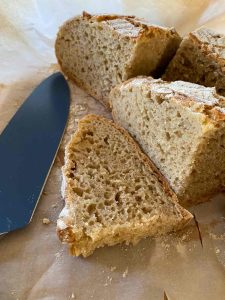Best Sourdough Bread Recipe
Best Sourdough Bread Recipe

This sourdough bread recipe has only three ingredients: Water, salt, and flour! It is a 100% heritage flour. It is surprisingly fluffier than most sourdough rye recipes that I’ve tried. The flavor is amazing and goes well with anything you would normally put in a sandwich. (Yum!) Yet, this recipe does not include any type of commercial yeast.
About the Starter
You will need a starter for this sourdough bread recipe. If you do not have one, and would like to make your own, I highly recommend the lazy sourdough guy, Ben Starr. I first developed a wheat sourdough with Farmhouse on Boone. She is great also, but, Ben touched on some details that really helped me. And I love his snarky voice. Seriously though, both are great resources on how to get started.
I have had my first starter about 4 years, and my rye starter about 2 years. I created my rye starter, by adding rye flour to my starter to make it a “rye starter” but I don’t recommend that. It was just easiest for me at the time. The process involves mixing flour with water and letting it sit. The next day, remove half and “feed” the starter another batch of flour and water. It can be tedious which is why I recommend going to these sources first. Then, with a good understanding, my recipe will make more sense to you. Maybe at some point, I’ll create a video on it. But then again, why? The chef does an excellent job.
Why Sourdough Bread?
When I first developed this recipe, I was looking for a sourdough recipe that didn’t have to be watched to determine when the starter was at it’s peak to use it. Also, my body seemed to adjust well to this sourdough bread even though I kind of try to stay away from wheat. If I eat fermented wheat bread, it really doesn’t bother me unless I eat a LOT. When I look at the foods recommended for my blood type, it tells me that rye is neutral for me, so I set out to find a sourdough rye recipe that could maybe even be a little beneficial for me. (Check out the D’Adamo website, ForYourtType.com to find out more about blood type foods.) However, fermented foods are tremendously healthy for all blood types (in my opinion) and are really fascinating to learn about. It is worth the effort to learn!
Making Sourdough Bread
This recipe takes time. You might want to allow yourself 2 days before you need to have it made. This recipe is slightly different from the rye bread post.
First Day:
Put the ingredients together. You will definitely want to use a digital scale for the first time making this. I haven’t been able to make it perfectly without it. Add the water and starter first in the bowl and mix. Add flour and salt. It feels great to mix with your hands, because somehow you get a better feel of how long to work it. When you mix it all together, it doesn’t have to be perfect. The dough will change as you allow it to sit for 10-24 hours. Place a plastic covering over the dough in a clean bowl and set it a space that isn’t too cold or isn’t too hot. I’ve included photo of how I cover my sourdough however, feel free to use a plastic bag as well.

Second Day:
Sometimes (depending on my flour) I will hear the bread crackling right around 24 hours! Almost like you can hear it fermenting. Either way, around 10-24 hours, I remove dough from bowl. It could be moist at this point. Put a lot of flour on a countertop and gently pour out the dough. Move the dough around the countertop and flour, using the sides of your hands. Fold it in gently and roll it around until it becomes a soft dough ball with flour around it. It may take some practice! This is where I like to use a Banneton basket or parchment paper to put my dough ball into. Place into bowl and let it sit, covered with a clean towel, for about 2-3 hours.

When the dough has been sitting for an hour, its a good time to put your dutch oven into the oven to preheat. After the dutch oven has been preheated at 525 degrees for an hour, carefully place parchment/dough into the dutch oven and bake at 425 degrees for 30 minutes covered. Then, take the cover off and bake an additional 8 minutes. Remove from oven and cool on a rack for at least an hour. Enjoy!
Equipment Used:
Try this for an alternative loaf pan!
Weck Jars (for keeping sourdough)
Some links are affiliate links, which means I make a small commission at no extra cost to you. See more info here.
This sourdough bread recipe has only three ingredients: Water, salt, and flour! It is a 100% heritage flour. It is surprisingly fluffier than most sourdough rye recipes that I’ve tried. The flavor is amazing and goes well with anything you would normally put in a…
Ingredients
12 oz of Water
20 oz of a heritage flour (such as Jovial-Eikorn ; see list above)
.6-.7 oz of sea salt
Instructions
1. In a medium size bowl, measure .4 oz of rye flour starter, cold from sitting in fridge for about a week or more.
2. Add 14 oz of filtered water and then 1 teaspoon of molasses and mix.
3. Mix in 16.4 oz of flour
4. Add sea salt.
5. Mix thoroughly and place into a clean bowl and allow to ferment over night. You may use a plastic bag or a bowl cover (as mentioned above).
6. After 10 - 24 hours, remove the dough from the bowl and massage into a round shape (for a floured beneton basket, or form into a bread pan shape and allow to sit for 4 more hours.
7. After 3 hours, heat the dutch oven in a 500 degree pan for one hour.
8. After 1 hour, place the dough from the beneton basket into the dutch oven lined with parchment paper.
9. Bake for 30 minutes at 425 degrees, covered.
10. Bake for 8 more minutes uncovered.
11. Remove from oven or bread pan and allow to cool on a rack.

Prep time: 20
Cook time: 40
Total time: 28
Servings: 10
Serving size: 1 slice
Meal type: Breakfast, Lunch, Dinner, Sidedish, Appetizer, Fermented, Sourdough
Special Equipment needed: dutch oven or bread pan, bowl to ferment; see list above for suggested equipment
